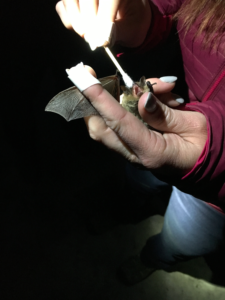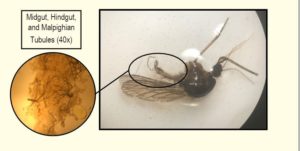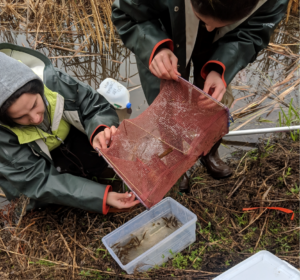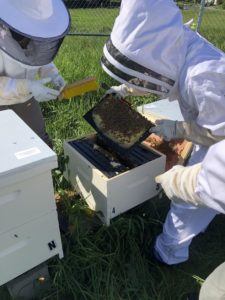
In the classroom, we often talk about important global issues such as climate change, land-use land-cover change and the impact of invasive species. However, for most citizens, including for many of our students, these large-scale issues are difficult to connect with their local day-to-day experiences. Conversely, it is also difficult to appreciate how the individual choices we make every day, such as what we buy, where we live, where we travel, and whether or not we vaccinate our children, culminate to global scale patterns.
In this blogpost, I propose a “glocalized” model of teaching and learning to help students better appreciate the connections between local and global issues in disease ecology. The term “glocal” and “glocalization” originates from the 1980s as a combination of “globalization” and “localization”, and refers to the merging of local and global perspectives, where the growing importance of continental or global issues combines with the increasing importance of local and regional differences. It was popularized in economics and political science by Thomas Friedman’s book (The World is Flat), and a good example is the adaptation of multinational corporations and brands (such as Starbucks or MacDonald’s) to the cultures and norms of the countries they expanded into at the end of the 20th century.
“Glocalized” learning and teaching focuses on blending and connecting local and global contexts when teaching and learning concepts that apply across different levels of scale, in fields such as sustainability, environmental science, and disease ecology. Learning becomes effective when put into local context because students are better able to relate to the content and material through familiar examples. The focus becomes discovering the connections between the local issues and the global concepts studied during class.
Every spring, I have the privilege of teaching Disease Ecology in my senior capstone (BIOL490) class at the Department of Biology at Eastern Washington University. In this class, senior undergraduate students learn the concepts of disease ecology (such as the dilution effect and spillover), as well as conduct hands on research projects in disease ecology in groups. While the concepts they learn are globally relevant, their research projects are focused on locally relevant systems, such as ticks and mosquitoes, and the diseases they transmit in our area. The aim is to use these local systems as examples through which the students can appreciate the global concepts discussed in class. I asked my students to provide short summaries of their research projects, which illustrate some of these connections. Please read them below.
Water nutrient conditions responsible for affecting the development and fecundity of disease vectors responsible for West Nile virus
Sydnee Henry, Dane Anderson and David Nguyen
Mosquitoes pose a serious threat to humans due to their role as disease vectors. The most common mosquito-transmitted pathogen in the United States is West Nile virus (WNV), which infects humans, horses, and birds. We wanted to understand the indirect effects of dissolved-nutrients (NO3 and PO4) on mosquito development time, survival, and fecundity. If a relationship can be established between the micronutrient content of mosquito breeding sites, larval development time, and adult fecundity, public health officials and disease ecologists could potentially identify at-risk water bodies (and in-turn control/neutralize them). The treatments were nitrate, phosphate, and a combination of nitrate and phosphate. There was 22 mg/L of NO3 and PO4 for each treatment. The positive control contained spring water, stagnant water from Turnbull Wildlife Refuge, and yeast for food. Each container was filled with 150 mL of spring water. There were 10 larvae per container. There were 3 replicates for each treatment and positive control. The living and the dead were counted each day at each life stage (stages 1-4 for larvae, in addition to pupae and adult stages). If adults emerged, sex and genus were determined using a dissecting microscope. Wingspan measurements were also taken as female wingspan is an indicator of fecundity. We found that NO3 and PO4 affects the the probability of pupation but does not affect the probability of emergence. The proportion pupated in each treatment was NO3 (19/30), control (24/40), NO3 and PO4 (7/30), and PO4 (1/30). We also found that NO3 and PO4 did not affect mean wingspan in adult mosquitoes or in the female subset.
Ultimately, results garnered indicated that NO3 and PO4 have an indirect effect on the probability of pupation, with more larvae pupating in the NO3 treatment. We initially contended that the NO3 and PO4 combination would significantly affect development time compared to the other treatments. Were this experiment to be repeated, ensuring homogenous age and genus of the mosquitoes is imperative. Additionally, measuring bacterial populations of the breeding containers would offer insight into the relationship between water nutrients and mosquito development and fecundity.
Survey of White Nose Syndrome (Pseudogymnoascus destructans) and General Health with Disease Progression in Little Brown Bats (Myotis lucifugus) in Lincoln County, Washington
Alejandro Batalla, Shelby Fettig, Matt Hellem, Elizabeth Peoples, Natalie Rudnev and Nate Sik
 Little brown bats (Myotis lucifugus) populate most of the United States. Currently, these bat populations are threatened due to a fungal skin infection caused by Pseudogymnoascus destructans (Pd), also called White Nose Syndrome (WNS). WNS affects bats during their winter hibernation and when infected, they utilize higher energy level to fight off the infection. This also results in decreased torpor and usage of fat reserves in search for food to compensate high energy use. This issue leads to starvation due to low food resource in winter and can ultimately lead to their death. WNS is mostly prevalent on the East Coast where it is estimated to have killed 94% of bat populations. However, records of disease incidence of WNS shows progression to the west coast and has been recently found in bat populations in Western Washington. Our group participated in a survey of bat populations in Lincoln County, WA with local Fish and Wildlife Services to determine health of little brown bats in the area. We used standard methods to determine infection status on site as well as culturing methods in the lab. We also measured forearm length, weight, and took counts of ectoparasites mites found on bat wings. We found no evidence of Pd, thus we cannot extrapolate any correlation between disease and ectoparasite presence. However, we did find that bats with parasites have bacterial communities that were less diverse and had less colonies of bacteria. This can indicate an increased chance of obtaining Pd within the colony on bats with ectoparasites. It is important to keep a close watch on local bat populations to better understand the disease and to keep population declines to a minimum.
Little brown bats (Myotis lucifugus) populate most of the United States. Currently, these bat populations are threatened due to a fungal skin infection caused by Pseudogymnoascus destructans (Pd), also called White Nose Syndrome (WNS). WNS affects bats during their winter hibernation and when infected, they utilize higher energy level to fight off the infection. This also results in decreased torpor and usage of fat reserves in search for food to compensate high energy use. This issue leads to starvation due to low food resource in winter and can ultimately lead to their death. WNS is mostly prevalent on the East Coast where it is estimated to have killed 94% of bat populations. However, records of disease incidence of WNS shows progression to the west coast and has been recently found in bat populations in Western Washington. Our group participated in a survey of bat populations in Lincoln County, WA with local Fish and Wildlife Services to determine health of little brown bats in the area. We used standard methods to determine infection status on site as well as culturing methods in the lab. We also measured forearm length, weight, and took counts of ectoparasites mites found on bat wings. We found no evidence of Pd, thus we cannot extrapolate any correlation between disease and ectoparasite presence. However, we did find that bats with parasites have bacterial communities that were less diverse and had less colonies of bacteria. This can indicate an increased chance of obtaining Pd within the colony on bats with ectoparasites. It is important to keep a close watch on local bat populations to better understand the disease and to keep population declines to a minimum.
Dirofilaria immitis and heartworm prevalence in mosquitoes and dogs in Spokane County
Lacey Sell, Hannah Bergquist, Irina Vasilchenko, Benjamin Thompson
 Dirofilaria immitis, is a parasitic roundworm that causes the disease called Heartworm. Heartworm can infect dogs, cats, wildlife mammals and even humans. It is a vector-borne disease that is transmitted through various species of mosquitoes including Aedes and Anopheles, both of which are present locally. With knowledge that a Spokane county canine was recently documented to have been locally infected with Heartworm, and research showing increases nation-wide, it was our objective to assess the prevalence of D. immitis within our area and see if increases in cases or even an epidemic could be likely in the near future. Local veterinary clinics, WA Dept. of Health and WA Dept. of Agriculture provided us with data on current positive cases of Heartworm both locally and throughout the United States. CO2-baited CDC light traps were then used at Turnbull National Wildlife Refuge in Cheney, WA to trap and collect mosquitoes, and those collected were dissected and observed under a light microscope to look for indications of Heartworm infection. Our results show that none of the trapped mosquitoes were infected with D. immitis, and that at this time Heartworm has not yet successfully invaded into the Spokane County region. However, control and prevention are still crucial, as increases of infection could be seen if proper measures are not taken.
Dirofilaria immitis, is a parasitic roundworm that causes the disease called Heartworm. Heartworm can infect dogs, cats, wildlife mammals and even humans. It is a vector-borne disease that is transmitted through various species of mosquitoes including Aedes and Anopheles, both of which are present locally. With knowledge that a Spokane county canine was recently documented to have been locally infected with Heartworm, and research showing increases nation-wide, it was our objective to assess the prevalence of D. immitis within our area and see if increases in cases or even an epidemic could be likely in the near future. Local veterinary clinics, WA Dept. of Health and WA Dept. of Agriculture provided us with data on current positive cases of Heartworm both locally and throughout the United States. CO2-baited CDC light traps were then used at Turnbull National Wildlife Refuge in Cheney, WA to trap and collect mosquitoes, and those collected were dissected and observed under a light microscope to look for indications of Heartworm infection. Our results show that none of the trapped mosquitoes were infected with D. immitis, and that at this time Heartworm has not yet successfully invaded into the Spokane County region. However, control and prevention are still crucial, as increases of infection could be seen if proper measures are not taken.
Mosquito surveillance and laboratory colonization at Turnbull National Wildlife Refuge
Shannon Robbins, Samantha Leader, Chiayo Koffman, Sonja Kuhta, Trever Dzedzy
The goal of our project was to gain a better understanding of the mosquito population in Turnbull National Wildlife Refuge for the purpose of monitoring an important local disease vector, as well as using these mosquitos to explore methods for colony establishment in Dr. Magori’s lab on Eastern Washington University campus. Turnbull National Wildlife Refuge has been monitored for mosquito population density and seasonality since 2014. Dr. Krisztian Magori and his students at Eastern Washington University have conducted these studies for previous years, starting later in season than our study. We did collect less mosquitos than in previous years as we expected, however we did discover more Aedes mosquitoes than previous collections. Colonization was also attempted previously without success. For colonization we have encountered similar obstacles to Dr. Magori’s previous attempts. Namely it is difficult to get the captive mosquito colony to accept a blood meal from the artificial delivery mechanisms we have tried. The only accepted feedings were when an arm was offered for them to feed off of, which is not a sustainable feeding method. Without a successful blood meal the colony will not breed, so it is critical for the establishment of a lab colony that a reliable method for blood meal delivery is developed. In order to achieve significant results with future studies it is imperative that collection protocols match previous efforts for reliable data, and colonization attempts could be successful with specific measures made to cater to the individual genus found in our area.
Presence and Abundance of Nematodes vs. Size and Season
Karina Cardenas, Martina Davis, Mahdieh Lashgari, Kristen Tattrie
 We considered the abundance of nematodes in brook stickleback populations versus body size, and seasonality, at the Turnbull Wildlife Refuge in Cheney, Washington. To start the project, we put minnow traps at three lakes in the refuge, Blackhorse, Middle Pine, and Kepple lakes. The next morning, we collected the minnow traps and euthanized the stickleback using MS-222. The stickleback were taken back to the lab to be measured, and dissected. We also used a sample of stickleback that had been frozen from collection in October of 2017, which we then compared the abundance of nematodes found in the Spring 2018 collections. In the Spring collections, there were no nematodes found, but in the Fall 2017 collection, there were 10% presence of nematodes in the stickleback. The presence in the Fall, but not in the Spring may be due to the difference in seasons, in that the Spring collections happened recently after a harsh winter, and the Fall collections happened after a hot, dry summer.
We considered the abundance of nematodes in brook stickleback populations versus body size, and seasonality, at the Turnbull Wildlife Refuge in Cheney, Washington. To start the project, we put minnow traps at three lakes in the refuge, Blackhorse, Middle Pine, and Kepple lakes. The next morning, we collected the minnow traps and euthanized the stickleback using MS-222. The stickleback were taken back to the lab to be measured, and dissected. We also used a sample of stickleback that had been frozen from collection in October of 2017, which we then compared the abundance of nematodes found in the Spring 2018 collections. In the Spring collections, there were no nematodes found, but in the Fall 2017 collection, there were 10% presence of nematodes in the stickleback. The presence in the Fall, but not in the Spring may be due to the difference in seasons, in that the Spring collections happened recently after a harsh winter, and the Fall collections happened after a hot, dry summer.
Honey bee health and gut microbial community in relation to their diet
Nicole Bilyeu, Sophie Owens, Emily Nimri, Morgan Sample, Daniel Franzese
 Honey bees play a large role in both ecology and the economy. For this reason, their declining numbers are beginning to raise concern. While much research is being done to try and save the bees, and the environment with it, there is yet to be a breakthrough. Our research aims to understand how different feeding treatments affect the health of honey bees. We examined 16 different colonies split evenly into two different locations. Half the colonies at each location were fed sugar while the other half were fed nectar. An initial measurement and sample was taken, followed by another the end of our three-week trial. We used three different measures to quantify the health of the colonies; changes in colony weight, quantity and diversity of gut microbes, and the number of frames containing brood in each hive. Our results showed that the different feeding treatments did not have a significant impact on colony health. Nor was there significance to having hives in different locations. It is necessary, however, to consider the shortness of our trial period when moving forward with these findings, as more time might have provided different results.
Honey bees play a large role in both ecology and the economy. For this reason, their declining numbers are beginning to raise concern. While much research is being done to try and save the bees, and the environment with it, there is yet to be a breakthrough. Our research aims to understand how different feeding treatments affect the health of honey bees. We examined 16 different colonies split evenly into two different locations. Half the colonies at each location were fed sugar while the other half were fed nectar. An initial measurement and sample was taken, followed by another the end of our three-week trial. We used three different measures to quantify the health of the colonies; changes in colony weight, quantity and diversity of gut microbes, and the number of frames containing brood in each hive. Our results showed that the different feeding treatments did not have a significant impact on colony health. Nor was there significance to having hives in different locations. It is necessary, however, to consider the shortness of our trial period when moving forward with these findings, as more time might have provided different results.
The idea of “glocalized” teaching and learning that I presented here is not new. Teachers and educators have always used local systems, such as detailed above, as examples for illustrating global phenomena. The difference here is the intentional conceptualization of these local experiences with the goal of making mental connections between local and global processes. Having just began this process, I do not have concrete evidence yet that I have achieved this goal. The next logical step would be the development of educational instruments, such as pre- and post-surveys to assess the effectiveness of such “glocalized” curricula in order to achieve these outcomes. Stay tuned for that next year!

Comments